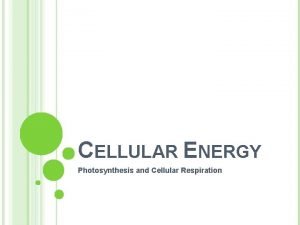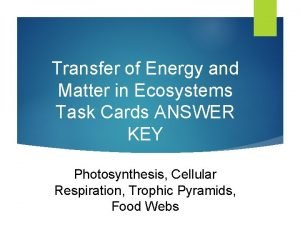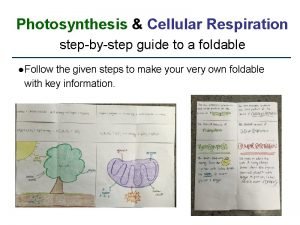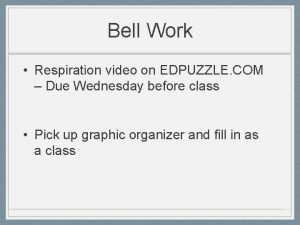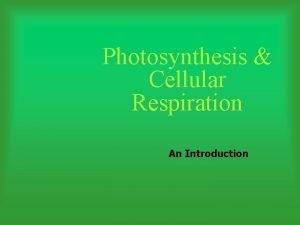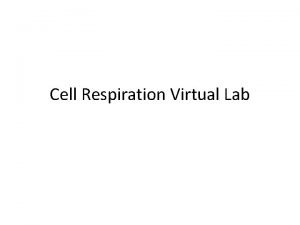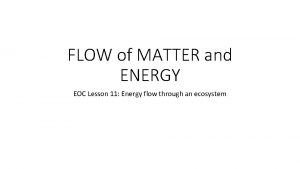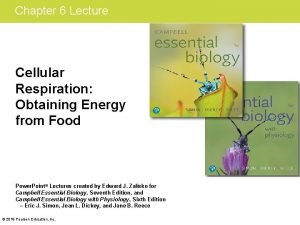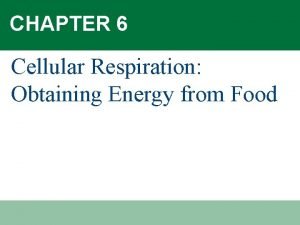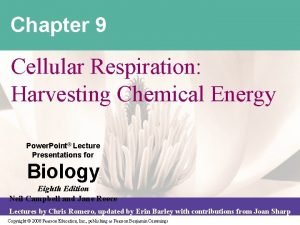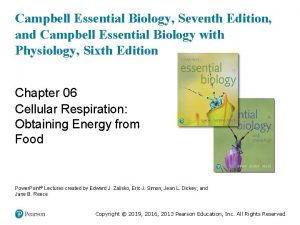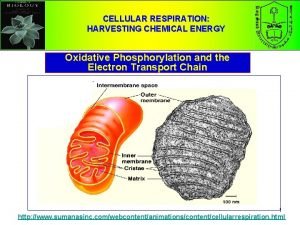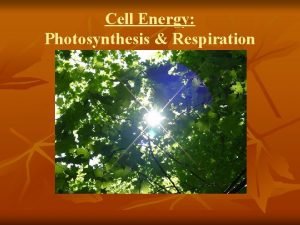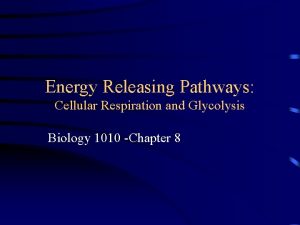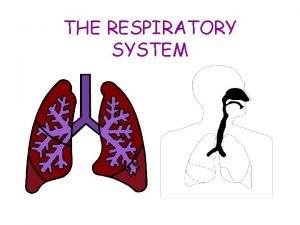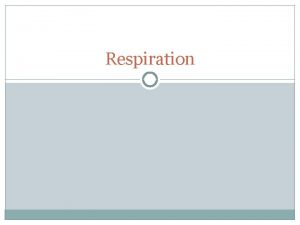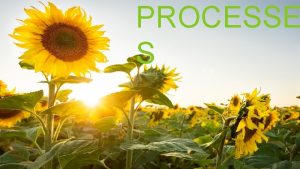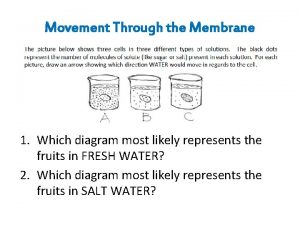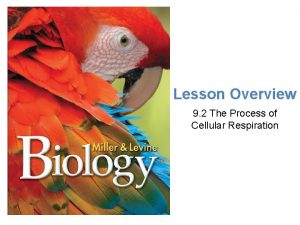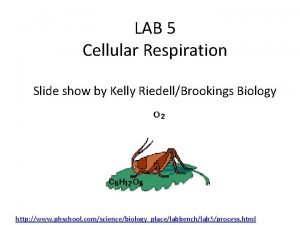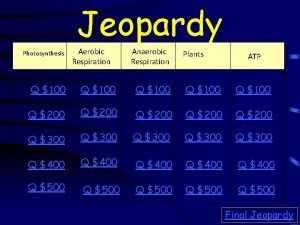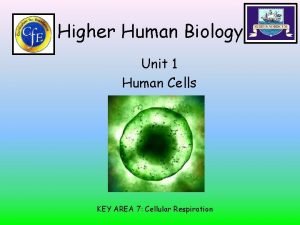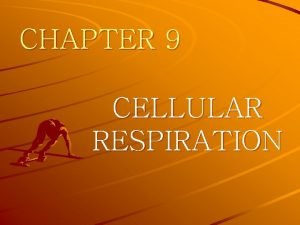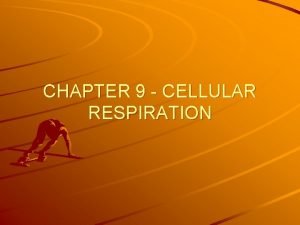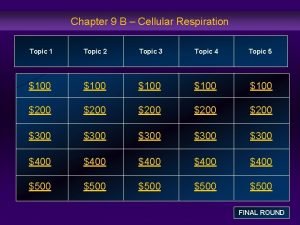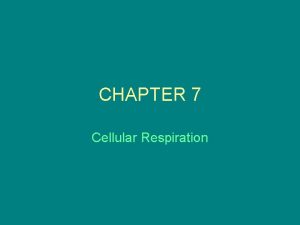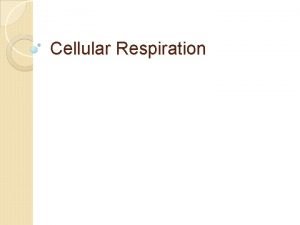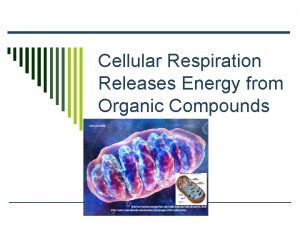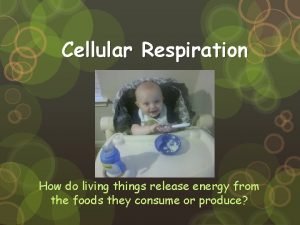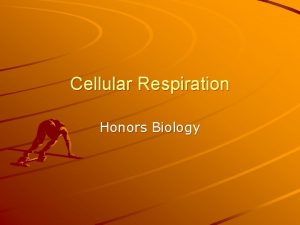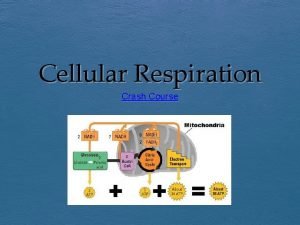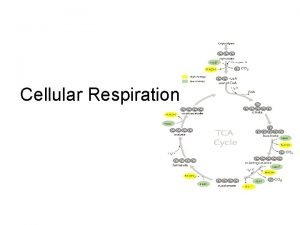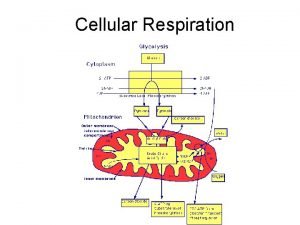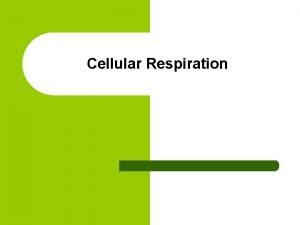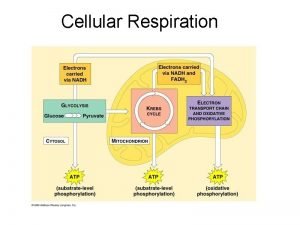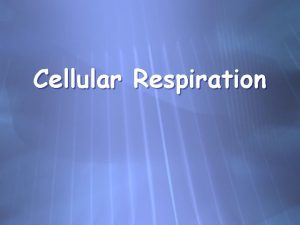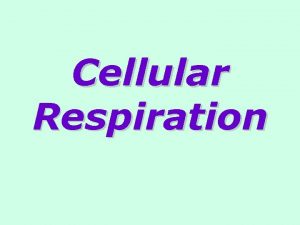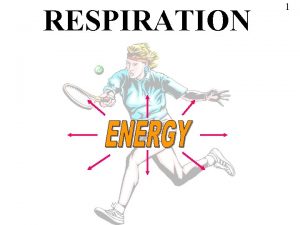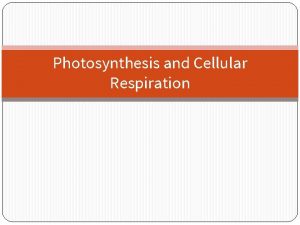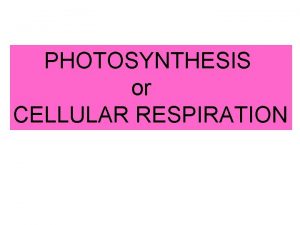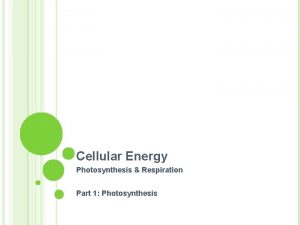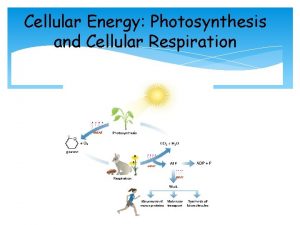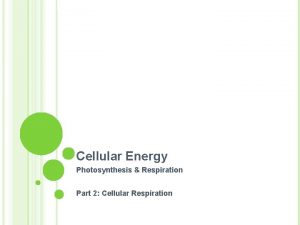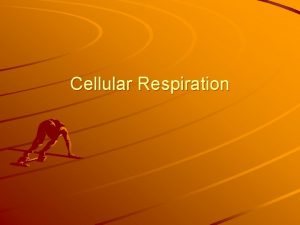ENERGY Photosynthesis Cellular Respiration 1 Releasing Food Energy























































- Slides: 55

ENERGY, Photosynthesis & Cellular Respiration 1

Releasing Food Energy 2

I. ATP: Energy In a Molecule • All food is broken down by the body into small molecules through digestion. • By the time food reaches your bloodstream, it has been broken down into nutrient molecules that can enter your cells. 3

I. ATP: Energy In a Molecule • Cellular reactions then break down the food molecules, releasing energy for the biological work your cells need to perform. • Energy = the ability to do work 4

I. ATP: Energy In a Molecule • ATP (adenosine triphosphate) = energy storing molecule 5

I. ATP: Energy In a Molecule • Cells STORE energy by bonding a third phosphate group to ADP (adenosine diphosphate) to form ATP. • Cells RELEASE energy when ATP breaks down into ADP and phosphate! 6

I. ATP: Energy In a Molecule ATP Energy from food ENERGY released for cells ADP + Phosphate 7

I. ATP: Energy In a Molecule • Within a cell, formation of ATP from ADP and phosphate occurs over and over, storing energy each time! 8

I. ATP: Energy In a Molecule • Cells use energy for: • Maintaining homeostasis • Eliminating wastes • Transmitting impulses (nerve cells) • Cellular movement (muscle cells) • Without ATP a cell would die! 9

10

I. OVERVIEW: “The Big Picture” • Photosynthesis = the process that provides energy for almost all life • Autotrophs = organisms that make their own food • Ex: plants • Photosynthesis requires: • The sun’s energy, water, and carbon dioxide to make carbohydrate molecules and oxygen as byproducts. 11

• The process of PHOTOSYNTHESIS can be summarized by the following equation: 6 CO 2 + 6 H 20 + sunlight C 6 H 12 O 6 + 6 O 2 12

13

I. OVERVIEW: “The Big Picture” • The energy stored in glucose and other carbohydrates can be used later to produce ATP during the process of cellular respiration • We’ll discuss cellular respiration in more detail very soon! 14

I. OVERVIEW: “The Big Picture” • The process of photosynthesis does NOT happen all at once; rather it occurs in 2 stages: 15

16

I. OVERVIEW: “The Big Picture” 1. STAGE 1 – called the light reactions (light dependent reactions) • Light energy is converted to chemical energy • Takes place when energy is captured from sunlight in the chlorophyll of the chloroplasts of plant cells. • A photosynthetic cell contains one to thousands of chloroplasts! 17

Stage 1: Light Reactions • Water is split into hydrogen ions, electrons, and oxygen (O 2) using the process called the electron transport chain. • The light energy is now converted to chemical energy, which is temporarily stored in ATP and NADPH (energy molecules) • The oxygen diffuses out of the chloroplasts (byproduct). • Occurs in the grana of the chloroplast. 18

Stage 2: Calvin Cycle 2. Stage 2 – called the Calvin cycle or dark reactions (Light independent reactions) • Carbon dioxide (CO 2) and the chemical energy stored in ATP and NADPH powers the formation of carbohydrate molecules (sugars, starch, and cellulose). 19

Stage 2: Calvin Cycle • Takes place the stroma of a chloroplast 20

21

22

Crash Course: Photosynthesis 23

Cellular Respiration 24

I. OVERVIEW: “The Big Picture” • Cellular respiration = an energy (ATP) releasing process: • PLANTS: sugars (C 6 H 12 O 6) produced during photosynthesis are broken down so energy is released • ANIMALS: sugars (C 6 H 12 O 6) produced during digestion are broken down so energy is released 25

I. OVERVIEW: “The Big Picture” • Formula: C 6 H 12 O 6 + 6 O 2 6 H 2 O + 6 CO 2 +ATP 26

I. OVERVIEW: “The Big Picture” • The PRODUCTS of photosynthesis, glucose and oxygen, are the REACTANTS used in cellular respiration • The WASTE PRODUCTS of cellular respiration, CO 2 and water, are the REACTANTS used in photosynthesis. 27

I. OVERVIEW: “The Big Picture” • Processes: 1. Glycolysis 2. Kreb’s Cycle (Citric Acid Cycle) 3. Electron Transport Chain (ETC) 28

II. Two Types of Cellular Respiration 1. Aerobic Respiration = OXYGEN is present • If OXYGEN is PRESENT, the products of glycolysis ENTER the pathways of aerobic respiration. • 2 major stages: Kreb’s Cycle & Electron Transport Chain • Produces large amounts of ATP 29

II. Two Types of Cellular Respiration 2. Anaerobic Respiration = No OXYGEN is present • Aka…Fermentation • No additional ATP is created AFTER glycolysis produces 2 ATP 30

Note: Both types of respiration BEGIN with glycolysis 31

III. Aerobic Respiration Processes: 1. GLYCOLYSIS • Occurs in the cytoplasm of the cell • Starting molecule: ONE molecule of glucose (C 6 H 12 O 6) 32

Glycolysis… • Produces : TWO pyruvic acids or pyruvates (C 3 H 6 O 3) • 2 ATP molecules • Attaches H’s to NAD+ (electron carrier) and forms NADH (High energy molecules) 33

III. Aerobic Respiration Processes: 2. KREB’S CYCLE (Citric Acid Cycle) • Aerobic respiration (requires oxygen) • Occurs in the mitochondrion 34

Kreb’s Cycle… • Starting molecules: 2 pyruvates and oxygen • Produces: NADH and FADH 2, CO 2, and 2 ATP molecules • Attaches H’s to NAD+ and FAD to create NADH and FADH 2 (these will be used to make more ATP in the ETC) 35

III. Aerobic Respiration Processes: 3. Electron Transport Chain (ETC)aerobic respiration • Aerobic process (requires oxygen) • Occurs in the inner membrane of the mitochondria 36

ETC… • Starting molecules: NADH and FADH 2 and oxygen • Uses the NADH and FADH 2 from the Kreb’s Cycle and another NADH from glycolysis 37

ETC… • Produces: Water and 32 ATP’s • FADH 2 and NADH, release H’s so they can attach to oxygen and produce water • Energy is released as a result of breaking down these molecules. 38

39

Importance of Aerobic Respiration • To transfer chemical energy (glucose) to a form of energy that is useable by cells (ATP)!!! • Total net gain of ATP molecule per 1 glucose = 36 ATP’s. 40

Relationship Between Photosynthesis and Cellular Respiration • The products of one reaction are the reactants for the other reaction • In an ecosystem, photosynthesis and cellular respiration form a cycle. 41

42

43

IV. Anaerobic Respiration Processes: • Occurs AFTER glycolysis, only if NO oxygen is present • No additional ATP is created after the 2 ATP’s from glycolysis! 44

Anaerobic Respiration 2 Types 1. Alcoholic Fermentation: • Occurs in yeast • Starting molecules: 2 pyruvates and NADH (from glycolysis) • Produces: ethyl alcohol and carbon dioxide • Bakers use alcoholic fermentation of yeast to make bread • Used to make wine and beer 45

Anaerobic Respiration 2 Types 2. Lactic Acid Fermentation: • Occurs in animals • Starting molecules: 2 pyruvates and NADH (from glycolysis) • Produces: lactic acid • Lactic acid fermentation by bacteria plays an essential role in manufacturing of food products such as yogurt and cheese. 46

Lactic Acid Fermentation • DURING EXERCISE: breathing cannot provide your body with all the oxygen it needs for aerobic respiration 47

Lactic Acid Fermentation & Exercise • When muscles run out of oxygen, cells switch to lactic acid fermentation. • Provides your muscles with the energy they need during exercise. 48

Lactic Acid Fermentation & Exercise • Side effects of lactic acid fermentation are muscle fatigue, pain, cramps, and soreness. • Most lactic acid made in the muscles diffuses into the bloodstream, then to the liver, where it is converted back to pyruvic acid when oxygen becomes available. 49

50

51

52

53

ye ast 54

Crash Course: ATP and Cellular Respiration 55
 Complementary processes
Complementary processes Cellular respiration formula
Cellular respiration formula What is the chemical equation for cellular respiration
What is the chemical equation for cellular respiration Formula for photosynthesis and cellular respiration
Formula for photosynthesis and cellular respiration Photosynthesis and cellular respiration diagram
Photosynthesis and cellular respiration diagram Cellular respiration foldable
Cellular respiration foldable Edpuzzle photosynthesis and cellular respiration
Edpuzzle photosynthesis and cellular respiration The chemical process of photosynthesis
The chemical process of photosynthesis Cellular respiration virtual lab snails and elodea
Cellular respiration virtual lab snails and elodea Photosynthesis and cellular respiration jeopardy
Photosynthesis and cellular respiration jeopardy Photosynthesis or cellular respiration
Photosynthesis or cellular respiration Cellular respiration obtaining energy from food
Cellular respiration obtaining energy from food Cellular respiration obtaining energy from food
Cellular respiration obtaining energy from food Chapter 9 cellular respiration harvesting chemical energy
Chapter 9 cellular respiration harvesting chemical energy Inputs of glycolysis
Inputs of glycolysis Energy flow in cellular respiration
Energy flow in cellular respiration Chapter 9 cellular respiration harvesting chemical energy
Chapter 9 cellular respiration harvesting chemical energy Chapter 9: cellular respiration: harvesting chemical energy
Chapter 9: cellular respiration: harvesting chemical energy Electron transport chain summary
Electron transport chain summary Chapter 8 section 2: photosynthesis
Chapter 8 section 2: photosynthesis Chapter 6 cell energy photosynthesis and respiration
Chapter 6 cell energy photosynthesis and respiration Energy-releasing pathways
Energy-releasing pathways The energy-releasing process that is fueled by oxygen
The energy-releasing process that is fueled by oxygen Cellular respiration redox
Cellular respiration redox What is the correct equation for cellular respiration?
What is the correct equation for cellular respiration? Cellular respiration steps
Cellular respiration steps Types of respiration
Types of respiration Fermentation diagram
Fermentation diagram Why is cellular respiration important
Why is cellular respiration important Cellular respiration chemical equation
Cellular respiration chemical equation Cellular respiration reactants
Cellular respiration reactants Photosynthesis recipe card
Photosynthesis recipe card What happens during glycolysis
What happens during glycolysis Overview of cellular respiration
Overview of cellular respiration Overview of aerobic respiration
Overview of aerobic respiration Overview of cellular respiration
Overview of cellular respiration Cellular respiration
Cellular respiration Lab bench cellular respiration
Lab bench cellular respiration What is the word equation for cellular respiration
What is the word equation for cellular respiration Higher human biology cellular respiration
Higher human biology cellular respiration What are the reactants and products of photosynthesis?
What are the reactants and products of photosynthesis? Cellular respiration releases
Cellular respiration releases Starting materials for cellular respiration
Starting materials for cellular respiration Chapter 8 section 3: cellular respiration
Chapter 8 section 3: cellular respiration Redox reaction in cellular respiration
Redox reaction in cellular respiration Where in the cell does cellular respiration occur
Where in the cell does cellular respiration occur Role of cellular respiration
Role of cellular respiration Cellular respiration releases
Cellular respiration releases Cellular respiration redox
Cellular respiration redox Respiration crash course
Respiration crash course Aerobic cellular respiration equation
Aerobic cellular respiration equation Process of cellular respiration
Process of cellular respiration Overall reaction of cellular respiration
Overall reaction of cellular respiration Krebs cycle occurs in
Krebs cycle occurs in Electron transport chain cellular respiration
Electron transport chain cellular respiration Where does cellular respiration take place
Where does cellular respiration take place



